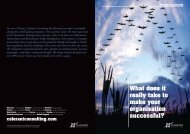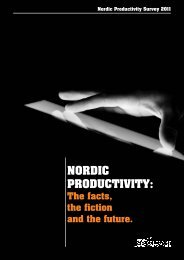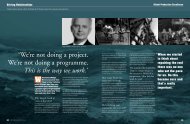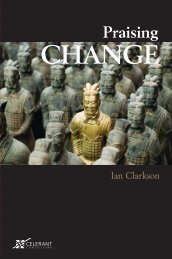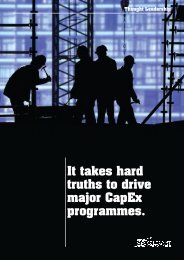Driving InsightsSuccess always demands a greater effort.Translating a global SupplyChain strategy into consistentreality means engagingpeople at every level of yourorganisation, says AdelOuederni, European SupplyChain Service Line Leaderat <strong>Celerant</strong> <strong>Consulting</strong>.You have to power your SCwith efficient humanwareand a clear, shared roadmap.An optimisedSupply Chaindoesn’t justalign plans,it also alignspractice.n many organisations today there’sIa serious disconnect between theflow charts that show how theirSupply Chain is supposed to workand what’s actually happening out in the field.<strong>Celerant</strong> <strong>Consulting</strong>’s global Supply Chainexperience has uncovered two main reasonsfor this. The first is a significant disconnectbetween what many companies believe they haveas processes and organisational models andwhat they really have in practice. The second isthat supply chains tend to have hidden bricks,sort of ‘black boxes’, too complex for theorganization to recognize, analyze and align.Working with companies across the globein various sectors, we see how these ‘blackboxes’ impact performance and derail overallsupply chain alignment.Supply Chains’ disjointed organizational structures,combined with increasing complexity and cumbersomeIT systems make these black boxesharder to identify and fix. For instance, some ITsystems, with obsolete or unsuited rules, canbecome a problematic rigidifying factor.Our view is that to develop an efficient, agileSupply Chain you need to recognize these blackboxes in order to realign the Supply Chain andhave it fully under control. This can be achievedonly by putting enabled ‘humanware’ back inthe driving seat, which supposes revisiting theorganisation, as well as the policies and leversit’s running with. This is why we put a strongfocus on the organisational dimension (people,roles & responsibilities, skills and capabilities,change management, etc.) when analyzing,then transforming supply chain performance.Also, the objective of any Supply Chain transformationshould not to be to fix a new staticmodel, but to redefine an adaptive, agile one.For this purpose, Supply Chain organisationshave to question the way they operate ona regular basis to discover how their realityis changing and how they can optimize theway the business produces, procures anddistributes. We see for example, that somecompanies use exactly the same logic in theirproduction with 20 customers as they did 10or 15 years ago with just few ones, leading tosignificant inefficiencies and a damagingdisconnect. Their business, product mix, supplybase, etc. has changed, so their Supply Chainmust be revisited to adapt to the new reality.14 CLOSEWORK® GLOBAL REVIEW 2012
In today’s dynamic, globalised markets complexityis increasing, visibility is decreasing and theparadigms that were adopted in the 90s and 20sare no longer enough to ensure performance.You have to satisfy the market, reduce costs,become more efficient and avoid permanentfire-fighting in dealing with new environmentsand constraints. The only way to achieve all thisis to become adaptable, agile and permanentlyin control of your Supply Chain. This can onlybe achieved by aligning all Supply Chaindimensions (Organization & People, Processes,Systems and tools, Footprint and infrastructure),end-to-end, from strategy to daily practice.In <strong>Celerant</strong>, we have a unique capability to movefrom Operations Strategy down to day-to-dayexecution where individuals make a hugedifference in putting together the full picture.We work alongside people at every level of thebusiness, because whatever your plans are intheory, if people running them don’t have themeans and capabilities to ensure that ideassuccessfully cascade from the CEO to the sharpend, your Supply Chain can fail. This also meansbeing able to take into account local facetsand cultures at every stage of Supply Chaintransformation projects. Then, needless to saythat in today’s complex environment, efficienthumanware is the foremost differentiator inbusiness adaptability.An efficient Supply Chain is the backbone ofevery successful business, but it has to be aflexible backbone, which means having robust,rather than rigid foundations. It must be able toregularly adapt to new trends and changes inthe market, as well as internal and externalnetwork mutations. This supposes to constantlycapture the influencing factors on the business.Supply Chain adaptability has to become anembedded gene within the business so that itcan follow a continuous evolution, instead ofhaving to undergo a perilous deep transformationevery couple of years or just be reshaped anderoded by the environment.The Six Pillars Of Supply ChainAdaptability Excellence<strong>Celerant</strong> <strong>Consulting</strong> believe that Supply Chainadaptability excellence is built on:An Aligned and Integrated Organisation at AllLevels: Not just internally, but also with keysuppliers and customers to ensure that all differentparts in the value chain have the same targets,work together smoothly and can collaborate toadapt collectively to the changing environment.Supply Chain is primarily about Organisationand People. In broad numbers, it’s 60% aboutpeople and organisation, 30% about processesand how value chain components are operated,and 10% about information systems and otherenabling tools. Organisation remains the key,but you cannot simply focus on one component:you have to focus on all three at the same time.An Adaptable Supply Chain Footprint: Regularlyreviewing and adapting your Supply Chainfootprint is essential to control costs and risks.It may currently make sense to buy componentsfrom China for example, but if this means reducingunit cost while significantly increasing leadtimes or quality issues, it will decrease youradaptability. So all key factors need to be inbalance. Footprint review is also about howmuch capacity you want to have in-house(‘base’ capacity) and how much you need to beable to trigger to adapt to variations (‘surge’capacity) for an optimal response to demand.Key Customer & Supplier Intelligence &Collaboration: In today’s fast moving environment,active customer and Supply Chain intelligenceis vital to help a business detect trends and pickup any signals which might mean additional risksor opportunities. This means going far beyondtransactional exchange, through EDI or otherforms of data communication; it means workingclosely with your suppliers and customers toanalyse the risks and opportunities and jointlycome up with timely, effective plans.Integrated Visibility & Planning: The mosteffective Supply Chains have the best visibility,from strategic planning, to tactical planning, toexecution. A business must then be able to revisitthese plans at any time and adapt to any changesin the environment based on a structured andoptimal Supply Chain response mode. IntegratedVisibility & Planning enables internal and externalalignment and collaboration, so that a businesscan anticipate issues and seize opportunities,not in a fire fighting manner, but with informeddecisions and robust rules.A Direct Link between Operational Excellence &Supply Chain Management: Businesses mighttalk about LEAN and Operational Excellencein general, but what is sometimes missing isthe link between Operational Excellence andoverall Supply Chain optimisation and agility.In our experience the two aren’t always hand inhand which is counter-productive. A businessmight have optimised sites or production lines,but that doesn’t necessarily mean its overallSupply Chain is synchronized and aligned.That’s why it’s vital to have a consistent linkbetween the way the overall Supply Chain isbeing operated and the way the execution ishappening at each individual node.A Back to Basics Overview: Many businesseshave been reshaped by acquisitions or mergers,or extended into new geographies or new marketsegments, and these additional layers can oftencorrode the existing Supply Chain rules or makethem irrelevant. Unfortunately, many rules areembedded and hidden in IT systems or otherforms of what we call black boxes, areas thatnobody controls or questions but which canmislead a business. So it’s key that in strategic,tactical and short term Supply Chain planning,existing policies are revisited to make sure thatthe business is being run according to optimisedrules and current reality, not the rules thatwere set 10 or 15 years ago, or uncontrolledderivatives of those outdated rules.‘ Supply Chain is primarilyabout Organisation and ChangeManagement. In broad numbers,60% of it is about people.’CLOSEWORK® GLOBAL REVIEW 2012 15




